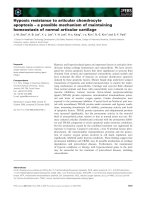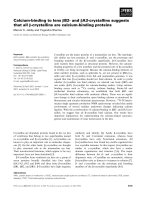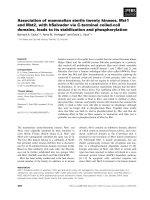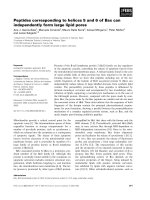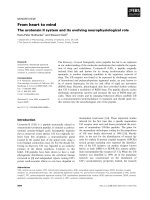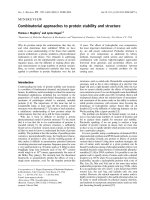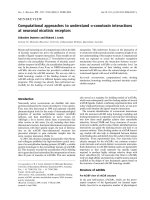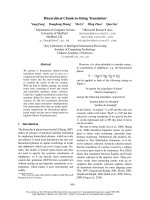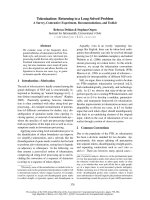Báo cáo khoa học: "Discriminative Strategies to Integrate Multiword Expression Recognition and Parsing" docx
Bạn đang xem bản rút gọn của tài liệu. Xem và tải ngay bản đầy đủ của tài liệu tại đây (166.24 KB, 9 trang )
Proceedings of the 50th Annual Meeting of the Association for Computational Linguistics, pages 204–212,
Jeju, Republic of Korea, 8-14 July 2012.
c
2012 Association for Computational Linguistics
Discriminative Strategies to Integrate Multiword Expression Recognition
and Parsing
Matthieu Constant
Universit
´
e Paris-Est
LIGM, CNRS
France
Anthony Sigogne
Universit
´
e Paris-Est
LIGM, CNRS
France
Patrick Watrin
Universit
´
e de Louvain
CENTAL
Belgium
patrick.watrin
@uclouvain.be
Abstract
The integration of multiword expressions in a
parsing procedure has been shown to improve
accuracy in an artificial context where such
expressions have been perfectly pre-identified.
This paper evaluates two empirical strategies
to integrate multiword units in a real con-
stituency parsing context and shows that the
results are not as promising as has sometimes
been suggested. Firstly, we show that pre-
grouping multiword expressions before pars-
ing with a state-of-the-art recognizer improves
multiword recognition accuracy and unlabeled
attachment score. However, it has no statis-
tically significant impact in terms of F-score
as incorrect multiword expression recognition
has important side effects on parsing. Sec-
ondly, integrating multiword expressions in
the parser grammar followed by a reranker
specific to such expressions slightly improves
all evaluation metrics.
1 Introduction
The integration of Multiword Expressions (MWE)
in real-life applications is crucial because such ex-
pressions have the particularity of having a certain
level of idiomaticity. They form complex lexical
units which, if they are considered, should signifi-
cantly help parsing.
From a theoretical point of view, the integra-
tion of multiword expressions in the parsing pro-
cedure has been studied for different formalisms:
Head-Driven Phrase Structure Grammar (Copestake
et al., 2002), Tree Adjoining Grammars (Schuler
and Joshi, 2011), etc. From an empirical point of
view, their incorporation has also been considered
such as in (Nivre and Nilsson, 2004) for depen-
dency parsing and in (Arun and Keller, 2005) in con-
stituency parsing. Although experiments always re-
lied on a corpus where the MWEs were perfectly
pre-identified, they showed that pre-grouping such
expressions could significantly improve parsing ac-
curacy. Recently, Green et al. (2011) proposed in-
tegrating the multiword expressions directly in the
grammar without pre-recognizing them. The gram-
mar was trained with a reference treebank where
MWEs were annotated with a specific non-terminal
node.
Our proposal is to evaluate two discriminative
strategies in a real constituency parsing context:
(a) pre-grouping MWE before parsing; this would
be done with a state-of-the-art recognizer based
on Conditional Random Fields; (b) parsing with
a grammar including MWE identification and then
reranking the output parses thanks to a Maxi-
mum Entropy model integrating MWE-dedicated
features. (a) is the direct realistic implementation of
the standard approach that was shown to reach the
best results (Arun and Keller, 2005). We will evalu-
ate if real MWE recognition (MWER) still positively
impacts parsing, i.e., whether incorrect MWER does
not negatively impact the overall parsing system.
(b) is a more innovative approach to MWER (de-
spite not being new in parsing): we select the final
MWE segmentation after parsing in order to explore
as many parses as possible (as opposed to method
(a)). The experiments were carried out on the French
Treebank (Abeill
´
e et al., 2003) where MWEs are an-
notated.
204
The paper is organized as follows: section 2 is
an overview of the multiword expressions and their
identification in texts; section 3 presents the two dif-
ferent strategies and their associated models; sec-
tion 4 describes the resources used for our exper-
iments (the corpus and the lexical resources); sec-
tion 5 details the features that are incorporated in the
models; section 6 reports on the results obtained.
2 Multiword expressions
2.1 Overview
Multiword expressions are lexical items made up
of multiple lexemes that undergo idiosyncratic con-
straints and therefore offer a certain degree of id-
iomaticity. They cover a wide range of linguistic
phenomena: fixed and semi-fixed expressions, light
verb constructions, phrasal verbs, named entities,
etc. They may be contiguous (e.g. traffic light) or
discontinuous (e.g. John took your argument into
account). They are often divided into two main
classes: multiword expressions defined through lin-
guistic idiomaticity criteria (lexicalized phrases in
the terminology of Sag et al. (2002)) and those de-
fined by statistical ones (i.e. simple collocations).
Most linguistic criteria used to determine whether a
combination of words is a MWE are based on syn-
tactic and semantic tests such as the ones described
in (Gross, 1986). For instance, the utterance at night
is a MWE because it does display a strict lexical
restriction (*at day, *at afternoon) and it does not
accept any inserting material (*at cold night, *at
present night). Such linguistically defined expres-
sions may overlap with collocations which are the
combinations of two or more words that cooccur
more often than by chance. Collocations are usu-
ally identified through statistical association mea-
sures. A detailed description of MWEs can be found
in (Baldwin and Nam, 2010).
In this paper, we focus on contiguous MWEs that
form a lexical unit which can be marked by a part-of-
speech tag (e.g. at night is an adverb, because of is a
preposition). They can undergo limited morphologi-
cal and lexical variations – e.g. traffic (light+lights),
(apple+orange+ ) juice – and usually do not al-
low syntactic variations
1
such as inserts (e.g. *at
1
Such MWEs may very rarely accept inserts, often limited
to single word modifiers: e.g. in the short term, in the very short
cold night). Such expressions can be analyzed at the
lexical level. In what follows, we use the term com-
pounds to denote such expressions.
2.2 Identification
The idiomaticity property of MWEs makes them
both crucial for Natural Language Processing appli-
cations and difficult to predict. Their actual iden-
tification in texts is therefore fundamental. There
are different ways for achieving this objective. The
simpler approach is lexicon-driven and consists in
looking the MWEs up in an existing lexicon, such
as in (Silberztein, 2000). The main drawback is
that this procedure entirely relies on a lexicon and
is unable to discover unknown MWEs. The use
of collocation statistics is therefore useful. For in-
stance, for each candidate in the text, Watrin and
Franc¸ois (2011) compute on the fly its association
score from an external ngram base learnt from a
large raw corpus, and tag it as MWE if the associa-
tion score is greater than a threshold. They reach ex-
cellent scores in the framework of a keyword extrac-
tion task. Within a validation framework (i.e. with
the use of a reference corpus annotated in MWEs),
Ramisch et al. (2010) developped a Support Vector
Machine classifier integrating features correspond-
ing to different collocation association measures.
The results were rather low on the Genia corpus
and Green et al. (2011) confirmed these bad results
on the French Treebank. This can be explained by
the fact that such a method does not make any dis-
tinctions between the different types of MWEs and
the reference corpora are usually limited to certain
types of MWEs. Furthermore, the lexicon-driven
and collocation-driven approaches do not take the
context into account, and therefore cannot discard
some of the incorrect candidates. A recent trend is
to couple MWE recognition with a linguistic ana-
lyzer: a POS tagger (Constant and Sigogne, 2011)
or a parser (Green et al., 2011). Constant and Si-
gogne (2011) trained a unified Conditional Random
Fields model integrating different standard tagging
features and features based on external lexical re-
sources. They show a general tagging accuracy of
94% on the French Treebank. In terms of Multi-
word expression recognition, the accuracy was not
term.
205
clearly evaluated, but seemed to reach around 70-
80% F-score. Green et al. (2011) proposed to in-
clude the MWER in the grammar of the parser. To
do so, the MWEs in the training treebank were anno-
tated with specific non-terminal nodes. They used a
Tree Substitution Grammar instead of a Probabilis-
tic Context-free Grammar (PCFG) with latent anno-
tations in order to capture lexicalized rules as well
as general rules. They showed that this formalism
was more relevant to MWER than PCFG (71% F-
score vs. 69.5%). Both methods have the advantage
of being able to discover new MWEs on the basis
of lexical and syntactic contexts. In this paper, we
will take advantage of the methods described in this
section by integrating them as features of a MWER
model.
3 Two strategies, two discriminative
models
3.1 Pre-grouping Multiword Expressions
MWER can be seen as a sequence labelling task
(like chunking) by using an IOB-like annotation
scheme (Ramshaw and Marcus, 1995). This implies
a theoretical limitation: recognized MWEs must be
contiguous. The proposed annotation scheme is
therefore theoretically weaker than the one proposed
by Green et al. (2011) that integrates the MWER in
the grammar and allows for discontinuous MWEs.
Nevertheless, in practice, the compounds we are
dealing with are very rarely discontinuous and if so,
they solely contain a single word insert that can be
easily integrated in the MWE sequence. Constant
and Sigogne (2011) proposed to combine MWE seg-
mentation and part-of-speech tagging into a single
sequence labelling task by assigning to each token a
tag of the form TAG+X where TAG is the part-of-
speech (POS) of the lexical unit the token belongs to
and X is either B (i.e. the token is at the beginning
of the lexical unit) or I (i.e. for the remaining posi-
tions): John/N+B hates/V+B traffic/N+B jams/N+I.
In this paper, as our task consists in jointly locating
and tagging MWEs, we limited the POS tagging to
MWEs only (TAG+B/TAG+I), simple words being
tagged by O (outside): John/O hates/O traffic/N+B
jams/N+I.
For such a task, we used Linear chain Conditional
Ramdom Fields (CRF) that are discriminative prob-
abilistic models introduced by Lafferty et al. (2001)
for sequential labelling. Given an input sequence of
tokens x = (x
1
, x
2
, , x
N
) and an output sequence
of labels y = (y
1
, y
2
, , y
N
), the model is defined
as follows:
P
λ
(y|x) =
1
Z(x)
.
N
t
K
k
logλ
k
.f
k
(t, y
t
, y
t−1
, x)
where Z(x) is a normalization factor depending
on x. It is based on K features each of them be-
ing defined by a binary function f
k
depending on
the current position t in x, the current label y
t
, the
preceding one y
t−1
and the whole input sequence
x. The tokens x
i
of x integrate the lexical value
of this token but can also integrate basic properties
which are computable from this value (for example:
whether it begins with an upper case, it contains a
number, its tags in an external lexicon, etc.). The
feature is activated if a given configuration between
t, y
t
, y
t−1
and x is satisfied (i.e. f
k
(t, y
t
, y
t−1
, x) =
1). Each feature f
k
is associated with a weight λ
k
.
The weights are the parameters of the model, to be
estimated. The features used for MWER will be de-
scribed in section 5.
3.2 Reranking
Discriminative reranking consists in reranking the n-
best parses of a baseline parser with a discriminative
model, hence integrating features associated with
each node of the candidate parses. Charniak and
Johnson (2005) introduced different features that
showed significant improvement in general parsing
accuracy (e.g. around +1 point in English). For-
mally, given a sentence s, the reranker selects the
best candidate parse p among a set of candidates
P (s) with respect to a scoring function V
θ
:
p
∗
= argmax
p∈P (s)
V
θ
(p)
The set of candidates P (s) corresponds to the n-best
parses generated by the baseline parser. The scor-
ing function V
θ
is the scalar product of a parameter
vector θ and a feature vector f:
V
θ
(p) = θ.f(p) =
m
j=1
θ
j
.f
j
(p)
where f
j
(p) corresponds to the number of occur-
rences of the feature f
j
in the parse p. According to
206
Charniak and Johnson (2005), the first feature f
1
is
the probability of p provided by the baseline parser.
The vector θ is estimated during the training stage
from a reference treebank and the baseline parser
ouputs.
In this paper, we slightly deviate from the original
reranker usage, by focusing on improving MWER
in the context of parsing. Given the n-best parses,
we want to select the one with the best MWE seg-
mentation by keeping the overall parsing accuracy as
high as possible. We therefore used MWE-dedicated
features that we describe in section 5. The training
stage was performed by using a Maximum entropy
algorithm as in (Charniak and Johnson, 2005).
4 Resources
4.1 Corpus
The French Treebank
2
[FTB] (Abeill
´
e et al., 2003)
is a syntactically annotated corpus made up of jour-
nalistic articles from Le Monde newspaper. We
used the latest edition of the corpus (June 2010)
that we preprocessed with the Stanford Parser pre-
processing tools (Green et al., 2011). It contains
473,904 tokens and 15,917 sentences. One benefit of
this corpus is that its compounds are marked. Their
annotation was driven by linguistic criteria such as
the ones in (Gross, 1986). Compounds are identified
with a specific non-terminal symbol ”MWX” where
X is the part-of-speech of the expression. They have
a flat structure made of the part-of-speech of their
components as shown in figure 1.
MWN
✟
✟
✟
✟
❍
❍
❍
❍
N
part
P
de
N
march
´
e
Figure 1: Subtree of MWE part de march
´
e (market
share): The MWN node indicates that it is a multiword
noun; it has a flat internal structure N P N (noun – pre-
prosition – noun)
The French Treebank is composed of 435,860 lex-
ical units (34,178 types). Among them, 5.3% are
compounds (20.8% for types). In addition, 12.9%
2
/>fr.php
of the tokens belong to a MWE, which, on average,
has 2.7 tokens. The non-terminal tagset is composed
of 14 part-of-speech labels and 24 phrasal ones (in-
cluding 11 MWE labels). The train/dev/test split is
the same as in (Green et al., 2011): 1,235 sentences
for test, 1,235 for development and 13,347 for train-
ing. The development and test sections are the same
as those generally used for experiments in French,
e.g. (Candito and Crabb
´
e, 2009).
4.2 Lexical resources
French is a resource-rich language as attested by
the existing morphological dictionaries which in-
clude compounds. In this paper, we use two large-
coverage general-purpose dictionaries: Dela (Cour-
tois, 1990; Courtois et al., 1997) and Lefff (Sagot,
2010). The Dela was manually developed in the
90’s by a team of linguists. We used the distribution
freely available in the platform Unitex
3
(Paumier,
2011). It is composed of 840,813 lexical entries in-
cluding 104,350 multiword ones (91,030 multiword
nouns). The compounds present in the resources re-
spect the linguistic criteria defined in (Gross, 1986).
The lefff is a freely available dictionary
4
that has
been automatically compiled by drawing from dif-
ferent sources and that has been manually validated.
We used a version with 553,138 lexical entries in-
cluding 26,311 multiword ones (22,673 multiword
nouns). Their different modes of acquisition makes
those two resources complementary. In both, lexical
entries are composed of a inflected form, a lemma,
a part-of-speech and morphological features. The
Dela has an additional feature for most of the mul-
tiword entries: their syntactic surface form. For in-
stance, eau de vie (brandy) has the feature NDN be-
cause it has the internal flat structure noun – prepo-
sition de – noun.
In order to compare compounds in these lexical
resources with the ones in the French Treebank, we
applied on the development corpus the dictionar-
ies and the lexicon extracted from the training cor-
pus. By a simple look-up, we obtained a prelimi-
nary lexicon-based MWE segmentation. The results
are provided in table 1. They show that the use of
external resources may improve recall, but they lead
3
/>4
/>207
to a decrease in precision as numerous MWEs in the
dictionaries are not encoded as such in the reference
corpus; in addition, the FTB suffers from some in-
consistency in the MWE annotations.
T L D T+L T+D T+L+D
recall 75.9 31.7 59.0 77.3 83.4 84.0
precision 61.2 52.0 55.6 58.7 51.2 49.9
f-score 67.8 39.4 57.2 66.8 63.4 62.6
Table 1: Simple context-free application of the lexical
resources on the development corpus: T is the MWE lex-
icon of the training corpus, L is the lefff, D is the Dela.
The given scores solely evaluate MWE segmentation and
not tagging.
In terms of statistical collocations, Watrin and
Franc¸ois (2011) described a system that lists all the
potential nominal collocations of a given sentence
along with their association measure. The authors
provided us with a list of 17,315 candidate nominal
collocations occurring in the French treebank with
their log-likelihood and their internal flat structure.
5 MWE-dedicated Features
The two discriminative models described in sec-
tion 3 require MWE-dedicated features. In order to
make these models comparable, we use two compa-
rable sets of feature templates: one adapted to se-
quence labelling (CRF-based MWER) and the other
one adapted to reranking (MaxEnt-based reranker).
The MWER templates are instantiated at each posi-
tion of the input sequence. The reranker templates
are instantiated only for the nodes of the candidate
parse tree, which are leaves dominated by a MWE
node (i.e. the node has a MWE ancestor). We define
a template T as follows:
• MWER: for each position n in the input se-
quence x,
T = f(x, n)/y
n
• RERANKER: for each leaf (in position n)
dominated by a MWE node m in the current
parse tree p,
T = f(p, n)/label(m)/pos(p, n)
where f is a function to be defined; y
n
is the out-
put label at position n; label(m) is the label of node
m and pos(p, n) indicates the position of the word
corresponding to n in the MWE sequence: B (start-
ing position), I (remaining positions).
5.1 Endogenous Features
Endogenous features are features directly extracted
from properties of the words themselves or from a
tool learnt from the training corpus (e.g. a tagger).
Word n-grams. We use word unigrams and bigrams
in order to capture multiwords present in the training
section and to extract lexical cues to discover new
MWEs. For instance, the bigram coup de is often
the prefix of compounds such as coup de pied (kick),
coup de foudre (love at first sight), coup de main
(help).
POS n-grams. We use part-of-speech unigrams
and bigrams in order to capture MWEs with irreg-
ular syntactic structures that might indicate the id-
iomacity of a word sequence. For instance, the POS
sequence preposition – adverb associated with the
compound depuis peu (recently) is very unusual in
French. We also integrated mixed bigrams made up
of a word and a part-of-speech.
Specific features. Due to their different use, each
model integrates some specific features. In order to
deal with unknown words and special tokens, we in-
corporate standard tagging features in the CRF: low-
ercase forms of the words, word prefixes of length 1
to 4, word suffice of length 1 to 4, whether the word
is capitalized, whether the token has a digit, whether
it is an hyphen. We also add label bigrams. The
reranker models integrate features associated with
each MWE node, the value of which is the com-
pound itself.
5.2 Exogenous Features
Exogenous features are features that are not entirely
derived from the (reference) corpus itself. They are
computed from external data (in our case, our lexical
resources). The lexical resources might be useful to
discover new expressions: usually, expressions that
have standard syntax like nominal compounds and
are difficult to predict from the endogenous features.
The resources are applied to the corpus through a
lexical analysis that generates, for each sentence, a
finite-state automaton TFSA which represents all the
possible analyses. The features are computed from
the automaton TFSA.
Lexicon-based features. We associate each word
with its part-of-speech tags found in our external
morphological lexicon. All tags of a word constitute
208
an ambiguity class ac. If the word belongs to a com-
pound, the compound tag is also incorporated in the
ambiguity class. For instance, the word night (either
a simple noun or a simple adjective) in the context at
night, is associated with the class adj noun adv+I as
it is located inside a compound adverb. This feature
is directly computed from TFSA. The lexical anal-
ysis can lead to a preliminary MWE segmentation
by using a shortest path algorithm that gives priority
to compound analyses. This segmentation is also a
source of features: a word belonging to a compound
segment is assigned different properties such as the
segment part-of-speech mwt and its syntactic struc-
ture mws encoded in the lexical resource, its relative
position mwpos in the segment (’B’ or ’I’).
Collocation-based features. In our collocation re-
source, each candidate collocation of the French
treebank is associated with its internal syntactic
structure and its association score (log-likelihood).
We divided these candidates into two classes: those
whose score is greater than a threshold and the other
ones. Therefore, a given word in the corpus can be
associated with different properties whether it be-
longs to a potential collocation: the class c and the
internal structure cs of the collocation it belongs to,
its position cpos in the collocation (B: beginning; I:
remaining positions; O: outside). We manually set
the threshold to 150 after some tuning on the devel-
opment corpus.
All feature templates are given in table 2.
Endogenous Features
w(n + i), i ∈ {−2, −1, 0, 1, 2}
w(n + i)/w(n + i + 1), i ∈ {−2, −1, 0, 1}
t(n + i), i ∈ {−2, −1, 0, 1, 2}
t(n + i)/t(n + i + 1), i ∈ {−2, −1, 0, 1}
w(n + i)/t(n + j), (i, j) ∈ {(1, 0), (0, 1), (−1, 0), (0, −1)}
Exogenous Features
ac(n)
mwt(n)/mwpos(n)
mws(n)/mwpos(n)
c(n)/cs(n)/cpos(n)
Table 2: Feature templates (f) used both in the MWER
and the reranker models: n is the current position in the
sentence, w(i) is the word at position i; t(i) is the part-
of-speech tag of w(i); if the word at absolute position i
is part of a compound in the Shortest Path Segmentation,
mwt(i) and mws(i) are respectively the part-of-speech
tag and the internal structure of the compound, mwpos(i)
indicates its relative position in the compound (B or I).
6 Evaluation
6.1 Experiment Setup
We carried out 3 different experiments. We first
tested a standalone MWE recognizer based on CRF.
We then combined MWE pregrouping based on
this recognizer and the Berkeley parser
5
(Petrov
et al., 2006) trained on the FTB where the com-
pounds were concatenated (BKYc). Finally, we
combined the Berkeley parser trained on the FTB
where the compounds are annotated with specific
non-terminals (BKY), and the reranker. In all exper-
iments, we varied the set of features: endo are all en-
dogenous features; coll and lex include all endoge-
nous features plus collocation-based features and
lexicon-based ones, respectively; all is composed of
both endogenous and exogenous features. The CRF
recognizer relies on the software Wapiti
6
(Lavergne
et al., 2010) to train and apply the model, and on
the software Unitex (Paumier, 2011) to apply lexical
resources. The part-of-speech tagger used to extract
POS features was lgtagger
7
(Constant and Sigogne,
2011). To train the reranker, we used a MaxEnt al-
gorithm
8
as in (Charniak and Johnson, 2005).
Results are reported using several standard mea-
sures, the F
1
score, unlabeled attachment and Leaf
Ancestor scores. The labeled F
1
score [F1]
9
, de-
fined by the standard protocol called PARSEVAL
(Black et al., 1991), takes into account the brack-
eting and labeling of nodes. The unlabeled attache-
ment score [UAS] evaluates the quality of unlabeled
5
We used the version adapted to French in
the software Bonsai (Candito and Crabb
´
e, 2009):
stat dep parsing.html.
The original version is available at:
We trained the
parser as follows: right binarization, no parent annotation, six
split-merge cycles and default random seed initialisation (8).
6
Wapiti can be found at It was con-
figured as follows: rprop algorithm, default L1-penalty value
(0.5), default L2-penalty value (0.00001), default stopping cri-
terion value (0.02%).
7
Available at v-
mlv.fr/˜mconstan/research/software/.
8
We used the following mathematical libraries PETSc et
TAO, freely available at and
/>9
Evalb tool available at We
also used the evaluation by category implemented in the class
EvalbByCat in the Stanford Parser.
209
dependencies between words of the sentence
10
. And
finally, the Leaf-Ancestor score [LA]
11
(Sampson,
2003) computes the similarity between all paths (se-
quence of nodes) from each terminal node to the root
node of the tree. The global score of a generated
parse is equal to the average score of all terminal
nodes. Punctuation tokens are ignored in all met-
rics. The quality of MWE identification was evalu-
ated by computing the F
1
score on MWE nodes. We
also evaluated the MWE segmentation by using the
unlabeled F
1
score (U). In order to compare both ap-
proaches, parse trees generated by BKYc were auto-
matically transformed in trees with the same MWE
annotation scheme as the trees generated by BKY.
In order to establish the statistical significance of
results between two parsing experiments in terms of
F
1
and UAS, we used a unidirectional t-test for two
independent samples
12
. The statistical significance
between two MWE identification experiments was
established by using the McNemar-s test (Gillick
and Cox, 1989). The results of the two experiments
are considered statistically significant with the com-
puted value p < 0.01.
6.2 Standalone Multiword recognition
The results of the standalone MWE recognizer are
given in table 3. They show that the lexicon-based
system (lex) reaches the best score. Accuracy is im-
proved by an absolute gain of +6.7 points as com-
pared with BKY parser. The strictly endogenous
system has a +4.9 point absolute gain, +5.4 points
when collocations are added. That shows that most
of the work is done by fully automatically acquired
features (as opposed to features coming from a man-
ually constructed lexicon). As expected, lexicon-
based features lead to a 5.3 point recall improve-
ment (with respect to non-lexicon based features)
whereas precision is stable. The more precise sys-
tem is the base one because it almost solely detects
compounds present in the training corpus; neverthe-
less, it is unable to capture new MWEs (it has the
10
This score is computed by using the tool available at
The constituent trees are
automatically converted into dependency trees with the tool
Bonsai.
11
Leaf-ancestor assessment tool available at
/>12
Dan Bikel’s tool available at
/>lowest recall). BKY parser has the best recall among
the non lexicon-based systems, i.e. it is the best one
to discover new compounds as it is able to precisely
detect irregular syntactic structures that are likely to
be MWEs. Nevertheless, as it does not have a lex-
icalized strategy, it is not able to filter out incorrect
candidates; the precision is therefore very low (the
worst).
P R F
1
F
1
≤ 40 U
base 78.0 68.3 72.8 71.2 74.3
endo 75.5 74.5 75.0 74.0 76.3
coll 76.6 74.4 75.5 74.9 77.0
lex 76.0 79.8 77.8 77.8 79.0
all 76.2 79.2 77.7 77.3 78.8
BKY 67.6 75.1 71.1 70.7 72.5
Stanford* - - - 70.1 -
DP-TSG* - - - 71.1 -
Table 3: MWE identification with CRF: base are the
features corresponding to token properties and word n-
grams. The differences between all systems are statisti-
cally significant with respect to McNemar’s test (Gillick
and Cox, 1989), except lex/all and all/coll;
lex/coll is ”border-line”. The results of the systems
based on the Stanford Parser and the Tree Substitution
Parser (DP-TSG) are reported from (Green et al., 2011).
6.3 Combination of Multiword Expression
Recognition and Parsing
We tested and compared the two proposed dis-
criminative strategies by varying the sets of MWE-
dedicated features. The results are reported in ta-
ble 4. Table 5 compares the parsing systems, by
showing the score differences between each of the
tested system and the BKY parser.
Strat. Feat. Parser F
1
LA UAS F
1
(MWE)
- - BKY 80.61 92.91 82.99 71.1
pre - BKYc 75.47 91.10 76.74 0.0
pre endo BKYc 80.23 92.69 83.62 74.9
pre coll BKYc 80.32 92.73 83.77 75.5
pre lex BKYc 80.66 92.81 84.16 77.4
pre all BKYc 80.51 92.77 84.05 77.2
post endo BKY 80.87 92.94 83.49 72.9
post coll BKY 80.71 92.85 83.16 71.2
post lex BKY 81.08 92.98 83.98 74.5
post all BKY 81.03 92.96 83.97 74.3
pre gold BKYc 83.73 93.77 90.08 95.8
Table 4: Parsing evaluation: pre indicates a MWE pre-
grouping strategy, whereas post is a reranking strategy
with n = 50. The feature gold means that we have ap-
plied the parser on a gold MWE segmentation.
210
∆F
1
∆UAS ∆F
1
(MWE)
pre post pre post pre post
endo -0.38 +0.26 +0.63 +0.50 +3.8 +1.8
coll -0.29 +0.10 +0.78 +0.17 +4.4 +0.1
lex +0.05 +0.47 +1.17 +0.99 +6.3 +3.4
Table 5: Comparison of the strategies with respect to
BKY parser.
Firstly, we note that the accuracy of the best re-
alistic parsers is much lower than that of a parser
with a golden MWE segmentation
13
(-2.65 and -5.92
respectively in terms of F-score and UAS), which
shows the importance of not neglecting MWE recog-
nition in the framework of parsing. Furthermore,
pre-grouping has no statistically significant impact
on the F-score
14
, whereas reranking leads to a sta-
tistically significant improvement (except for col-
locations). Both strategies also lead to a statisti-
cally significant UAS increase. Whereas both strate-
gies improve the MWE recognition, pre-grouping
is much more accurate (+2-4%); this might be due
to the fact that an unlexicalized parser is limited in
terms of compound identification, even within n-
best analyses (cf. Oracle in table 6). The benefits of
lexicon-based features are confirmed in this experi-
ment, whereas the use of collocations in the rerank-
ing strategy seems to be rejected.
endo coll lex all oracle
n=1 80.61
(71.1)
n=5 80.74 80.88 81.03 81.05 83.17
(71.5) (71.7) (73.4) (73.3) (74.6)
n=20 80.98 80.72 81.09 81.01 84.76
(72.9) (70.6) (73.6) (73.0) (75.5)
n=50 80.87 80.71 81.08 81.03 85.21
(72.9) (71.2) (74.5) (74.3) (76.4)
n=100 80.69 80.53 81.12 80.93 85.54
(72.0) (70.0) (74.4) (73.7) (76.4)
Table 6: Reranker F
1
evaluation with respect to n and the
types of features. The F
1
(MWE) is given in parenthesis.
Table 7 shows the results by category. It indi-
cates that both discriminative strategies are of in-
terest in locating multiword adjectives, determiners
and prepositions; the pre-grouping method appears
to be particularly relevant for multiword nouns and
13
The F
1
(MWE) is not 100% with a golden segmentation be-
cause of tagging errors by the parser.
14
Note that we observe an increase of +0.5 in F
1
on the de-
velopment corpus with lexicon-based features.
adverbs. However, it performs very poorly in multi-
word verb recognition. In terms of standard parsing
accuracy, the pre-grouping approach has a very het-
erogeneous impact: Adverbial and Adjective Modi-
fier phrases tend to be more accurate; verbal kernels
and higher level constituents such as relative and
subordinate clauses see their accuracy level drop,
which shows that pre-recognition of MWE can have
a negative impact on general parsing accuracy as
MWE errors propagate to higher level constituents.
cat #gold BKY endo lex endo lex
(pre) (pre) (post) (post)
MWET 4 0.0 N/A N/A N/A N/A
MWA 22 37.2 +15.2 +21.3 +0.9 +4.7
MWV 47 62.1 -9.7 -13.2 +1.7 +2.5
MWD 24 62.1 +7.3 +10.2 0.0 +1.2
MWN 860 68.2 +4.0 +7.0 +1.7 +4.2
MWADV 357 72.1 +3.8 +6.4 +3.4 +4.1
MWPRO 31 84.2 -3.5 -0.9 0.0 0.0
MWP 294 79.1 +4.3 +5.8 +0.4 +1.1
MWC 86 85.7 +0.9 +3.7 +0.2 +1.0
Sint 209 47.2 -7.7 -8.7 +0.1 -0.2
AdP 86 48.8 +1.2 +3.0 +3.4 +5.1
Ssub 406 60.8 -1.1 -1.1 -0.3 -0.5
VPpart 541 63.2 -2.8 -2.1 -0.5 -1.6
Srel 408 74.8 -3.4 -3.5 -0.3 -0.6
VPinf 781 75.2 0.0 -0.1 -0.3 -0.3
COORD 904 75.2 +0.2 +0.4 -0.3 -0.4
PP 4906 76.7 -0.8 -0.3 +0.5 +0.7
AP 1482 74.5 +3.2 +3.9 +0.7 +1.6
NP 9023 79.8 -1.1 -0.8 +0.1 +0.2
VN 3089 94.0 -2.0 -1.0 0.0 0.0
Table 7: Evaluation by category with respect to BKY
parser. The BKY column indicates the F
1
of BKY parser.
7 Conclusions and Future Work
In this paper, we evaluated two discriminative strate-
gies to integrate Multiword Expression Recognition
in probabilistic parsing: (a) pre-grouping MWEs
with a state-of-the-art recognizer and (b) MWE
identification with a reranker after parsing. We
showed that MWE pre-grouping significantly im-
proves compound recognition and unlabeled depen-
dency annotation, which implies that this strategy
could be useful for dependency parsing. The rerank-
ing procedure evenly improves all evaluation scores.
Future work could consist in combining both strate-
gies: pre-grouping could suggest a set of potential
MWE segmentations in order to make it more flexi-
ble for a parser; final decisions would then be made
by the reranker.
211
Acknowlegments
The authors are very grateful to Spence Green for his
useful help on the treebank, and to Jennifer Thewis-
sen for her careful proof-reading.
References
A. Abeill
´
e and L. Cl
´
ement and F. Toussenel. 2003.
Building a treebank for French. Treebanks. In A.
Abeill
´
e (Ed.). Kluwer. Dordrecht.
A. Arun and F. Keller. 2005. Lexicalization in crosslin-
guistic probabilistic parsing: The case of French. In
ACL.
E. Black, S. Abney, D. Flickinger, C. Gdaniec, R. Gr-
ishman, P. Harrison, D. Hindle, R. Ingria, F. Jelinek,
J. Klavans, M. Liberman, M. Marcus, S. Roukos, B.
Santorini and T. Strzalkowski. 1991. A procedure for
quantitatively comparing the syntactic coverage of En-
glish grammars. In Proceedings of the DARPA Speech
and Natural Language Workshop.
T. Baldwin and K.S. Nam. 2010. Multiword Ex-
pressions. Handbook of Natural Language Process-
ing, Second Edition. CRC Press, Taylor and Francis
Group.
M. -H. Candito and B. Crabb
´
e. 2009. Improving gen-
erative statistical parsing with semi-supervised word
clustering. Proceedings of IWPT 2009.
E. Charniak and M. Johnson. 2005. Coarse-to-Fine n-
Best Parsing and MaxEnt Discriminative Reranking.
Proceedings of the 43rd Annual Meeting of the Asso-
ciation for Computational Linguistics (ACL’05).
M. Constant and A. Sigogne. 2011. MWU-aware Part-
of-Speech Tagging with a CRF model and lexical re-
sources. In Proceedings of the Workshop on Multi-
word Expressions: from Parsing and Generation to the
Real World (MWE’11).
A. Copestake, F. Lambeau, A. Villavicencio, F. Bond,
T. Baldwin, I. Sag, D. Flickinger. 2002. Multi-
word Expressions: Linguistic Precision and Reusabil-
ity. Proceedings of the Third International Conference
on Language Resources and Evaluation (LREC 2002).
B. Courtois. 1990. Un syst
`
eme de dictionnaires
´
electroniques pour les mots simples du franc¸ais.
Langue Franc¸aise. Vol. 87.
B. Courtois, M. Garrigues, G. Gross, M. Gross, R.
Jung, M. Mathieu-Colas, A. Monceaux, A. Poncet-
Montange, M. Silberztein and R. Viv
´
es. 1997. Dic-
tionnaire
´
electronique DELAC : les mots compos
´
es bi-
naires. Technical Report. n. 56. LADL, University
Paris 7.
L. Gillick and S. Cox. 1989. Some statistical issues in
the comparison of speech recognition algorithms. In
Proceedings of ICASSP’89.
S. Green, M C. de Marneffe, J. Bauer and C. D. Man-
ning. 2011. Multiword Expression Identification with
Tree Substitution Grammars: A Parsing tour de force
with French. In Empirical Method for Natural Lan-
guage Processing (EMNLP’11).
M. Gross. 1986. Lexicon Grammar. The Representa-
tion of Compound Words. In Proceedings of Compu-
tational Linguistics (COLING’86).
J. Lafferty and A. McCallum and F. Pereira. 2001. Con-
ditional random Fields: Probabilistic models for seg-
menting and labeling sequence data. In Proceedings of
the Eighteenth International Conference on Machine
Learning (ICML 2001).
T. Lavergne, O. Capp
´
e and F. Yvon. 2010. Practical Very
Large Scale CRFs. In ACL.
J. Nivre and J. Nilsson. 2004. Multiword units in syntac-
tic parsing. In Methodologies and Evaluation of Mul-
tiword Units in Real-World Applications (MEMURA).
S. Paumier. 2011. Unitex 3.9 documentation.
/>S. Petrov, L. Barrett, R. Thibaux and D. Klein. 2006.
Learning accurate, compact and interpretable tree an-
notation. In ACL.
C. Ramisch, A. Villavicencio and C. Boitet. 2010. mwe-
toolkit: a framework for multiword expression identi-
fication. In LREC.
L. A. Ramshaw and M. P. Marcus. 1995. Text chunking
using transformation-based learning. In Proceedings
of the 3rd Workshop on Very Large Corpora.
I. A. Sag, T. Baldwin, F. Bond, A. Copestake and D.
Flickinger. 2002. Multiword Expressions: A Pain in
the Neck for NLP. In CICLING 2002. Springer.
B. Sagot. 2010. The Lefff, a freely available, accurate
and large-coverage lexicon for French. In Proceed-
ings of the 7th International Conference on Language
Resources and Evaluation (LREC’10).
G. Sampson and A. Babarczy. 2003. A test of the leaf-
ancestor metric for parsing accuracy. Natural Lan-
guage Engineering. Vol. 9 (4).
Seddah D., Candito M H. and Crabb B. 2009. Cross-
parser evaluation and tagset variation: a French tree-
bank study. Proceedings of International Workshop
on Parsing Technologies (IWPT’09).
W. Schuler, A. Joshi. 2011. Tree-rewriting models of
multi-word expressions. Proceedings of the Workshop
on Multiword Expressions: from Parsing and Genera-
tion to the Real World (MWE’11).
M. Silberztein. 2000. INTEX: an FST toolbox. Theoret-
ical Computer Science, vol. 231(1).
P. Watrin and T. Franc¸ois. 2011. N-gram frequency
database reference to handle MWE extraction in NLP
applications. In Proceedings of the 2011 Workshop on
MultiWord Expressions.
212
